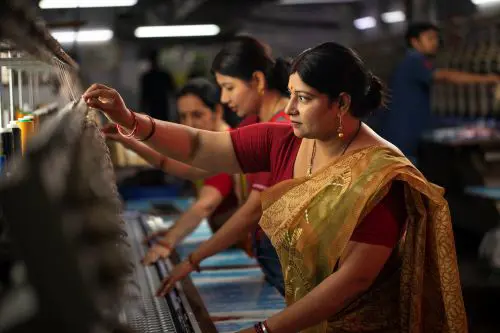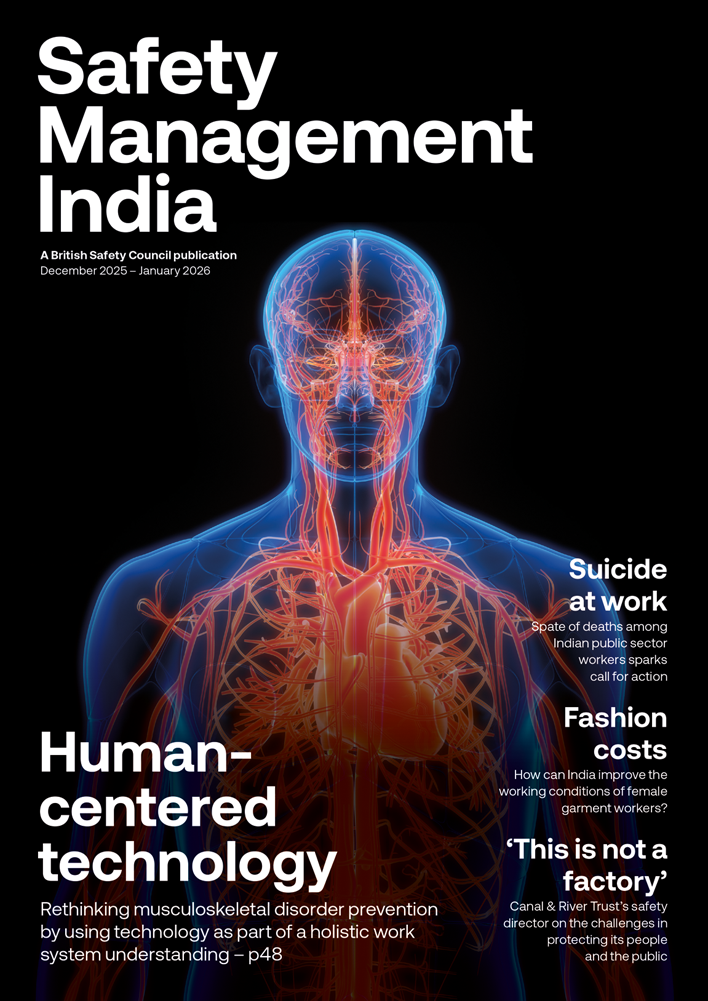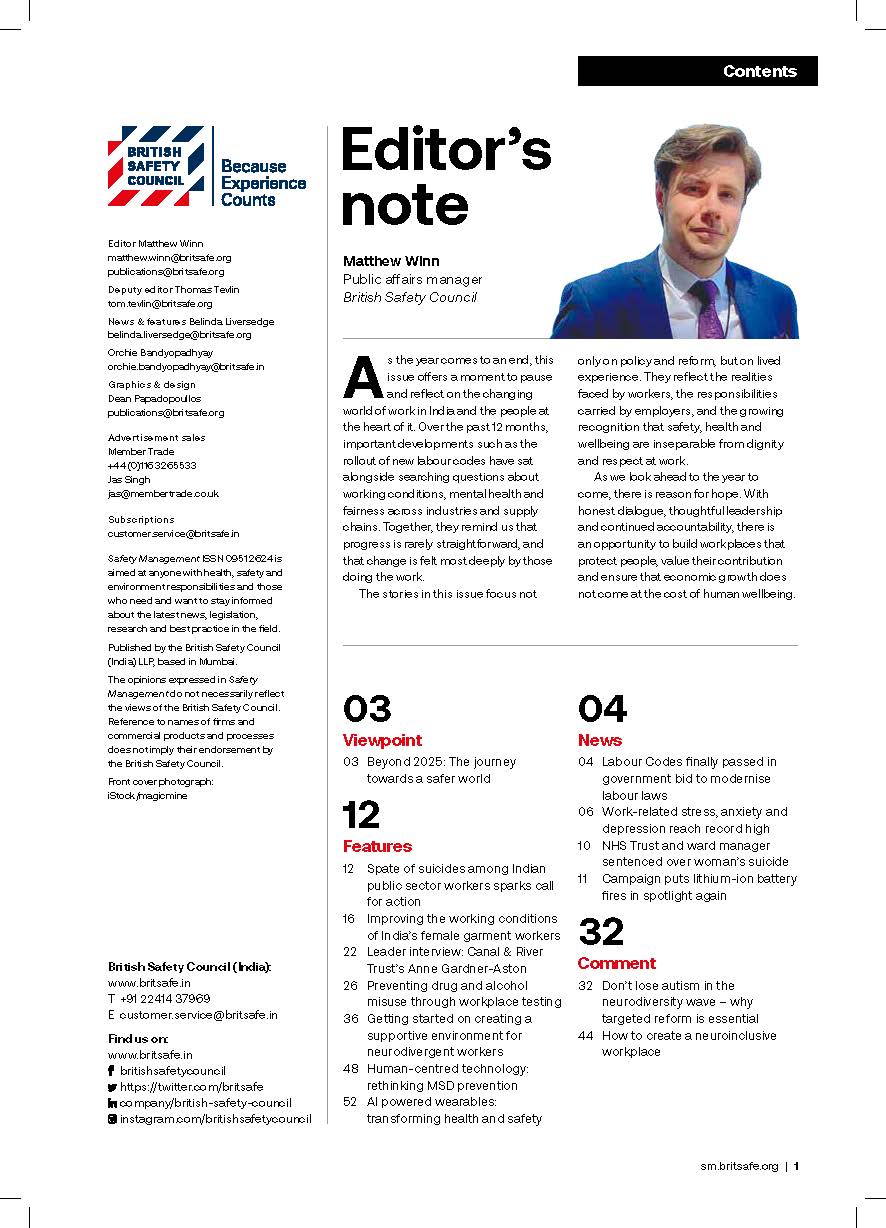Engineered stone dust contains up to 95 per cent silica, and younger workers are dying in its wake from a disease known as accelerated silicosis. Are we going fast enough to address the problem?
Features
A deadlier kind of dust
Marek Marzec probably best describes engineered stone dust’s potency in his interview filmed by Channel 4 shortly before his death on 30 November 2024.
From his hospital bed, lungs heaving, the Polish stonemason spoke of working in a ‘tornado’ of dust, with only a mask and no extractor for protection. “It’s important for me to speak out. This illness is just the beginning,” he said. “I’m sure more people will fall ill.”
Marek, 48, died from acute silicosis traced back to his exposure while making and cutting kitchen worktops in the UK – he had come to this country for work from Poland, and his exposure happened during that time, over at least three years. “I have been left unable to breathe and in terrible pain. I cannot tell you how angry I am that I was allowed to work in these conditions and that my life has been cut short simply for doing my job,” he said in an interview published by his solicitors at Leigh Day.
 Engineered stone has a high percentage of respirable crystalline silica and is a dangerous substance when breathed in as dust. Photograph: iStock
Engineered stone has a high percentage of respirable crystalline silica and is a dangerous substance when breathed in as dust. Photograph: iStock
Marek is one of a spate of such cases. Wassam al Jundi, aged 28, died on 30 May 2024 due to severe silicosis. Lydia Brown, the coroner who investigated his death, writes in her report: “Wassam had been working with artificial stone products... The dust created when these products are cut, sanded and carved creates respirable crystalline silica (RCS) and is too fine to see with normal lighting.
“It is recognised to cause silicosis if inhaled which causes a hardening or scarring of the lung tissue with initially no symptoms. Once silicosis develops it is untreatable apart from offering lung transplantation. There are a number of patients in the UK currently awaiting lung transplants due to RCS exposure from their workplaces.”
Brown’s report was sent to HSE, demanding a response by 23 December 2024 with “details of action taken or proposed to be taken”. So, what has happened since that urgent request? And will the efforts be enough to prevent more cases?
 Marek, 48, died from acute silicosis traced back to his exposure while making and cutting kitchen worktops in the UK. Photograph: Leigh Day
Marek, 48, died from acute silicosis traced back to his exposure while making and cutting kitchen worktops in the UK. Photograph: Leigh Day
The story of silicosis
First, we must appreciate how alarming deaths from accelerated silicosis are in the context of occupational lung disease in the UK. Silicosis is an old disease that’s existed for a long time, at least since Roman times, but it usually takes decades to develop, emerging in older age – known as a ‘long latency’ disease.
The tragic, accelerated cases described above are part of a relatively new phenomenon seen in the past decade globally in which workers are dying much younger. According to a 2024 study led by the Department of Occupational Lung Disease at the Royal Brompton Hospital, they are seeing silicosis patients with an average age of 34.
Another recent study of cases in Australia, which looked at compensation claims, found the average claimant was 39 years, compared with 50 just eight years ago. Lead author, Dr Ryan Hoy, said: “The stone benchtop industry is a multi-billion-dollar industry, employing hundreds of thousands of workers internationally. Our study has demonstrated an alarmingly rapid increase in cases of silicosis caused by work with artificial stone.”
 “Most manufacturers in this sector don’t want to make their workers ill, they just want to focus on business." Photograph: iStock
“Most manufacturers in this sector don’t want to make their workers ill, they just want to focus on business." Photograph: iStock
A more potent form of RCS
Before we look at the response to the crisis, we need to understand why artificial stone, also known as quartz or engineered stone, is so harmful. Silica is a natural substance found in rocks, sand and clay – not in itself harmful.
When silica-containing materials are cut, during grinding, cutting and finishing processes, a deadly fine dust known as respirable crystalline silica, or RCS, is released, explains Kevin Bampton, Chief Executive Officer of the British Occupational Hygiene Society: “It’s respirable in the sense it’s small enough to go deep into your lungs. It’s crystalline because it’s created from breaking up bigger bits of silica. It has sharp and jagged edges, and that morphology is the thing that your body doesn’t like – it goes right down into the smallest part of your lungs. And then your body tries to cope with it.”
Engineered stone has a high percentage of crystalline silica – up to 95 per cent. This makes it more dangerous and when workers are exposed to huge doses of it, the disease arises far sooner.
 Chest x-ray transition showing accelerated silicosis, with image (A) showing the chest X-ray 10 years prior and (B) the chest X-ray at the time of diagnosis. Photograph: From an article by Patino S, Izquierdo-Pretel G (July 05, 2022) A Case Report of Accelerated Pulmonary Silicosis
Chest x-ray transition showing accelerated silicosis, with image (A) showing the chest X-ray 10 years prior and (B) the chest X-ray at the time of diagnosis. Photograph: From an article by Patino S, Izquierdo-Pretel G (July 05, 2022) A Case Report of Accelerated Pulmonary Silicosis
‘Artificial stone health risk not clear’
In HSE’s response to the coroner, shared with Safety Management, it explains that “exposure to RCS is preventable where adequate control measures are in place to protect workers” and that the relevant laws are the Health and Safety at Work Act 1974 and the Control of Substances Hazardous to Health Regulations 2002 (COSHH).
HSE points out its free guidance, setting out how employers should protect their workers from exposure to RCS. In January 2025, HSE published new simplified advice, aimed at installers of stone worktops, as well as their managers and supervisors, to remind them of the steps they must take to control the exposure risk.
The new simplified advice has been helpful, says Bampton, who believes employers had not properly understood engineered stone’s risks before. “Most manufacturers in this sector don’t want to make their workers ill, they just want to focus on business. They were aware of things like the weight of the slabs and even noise, but they just didn’t get the seriousness of the risk from dust. It has been very helpful for HSE to make people aware. It hasn’t been very clear [to date] that artificial stone comes with a health risk in terms of dust.”
 The online tool created by BOHS, influentialmg.com and HSE's expert team. View it: live.sixtylearn.com/v/website-naMB
The online tool created by BOHS, influentialmg.com and HSE's expert team. View it: live.sixtylearn.com/v/website-naMB
Already a lot of ignorance
The UK has the highest death rate for lung conditions in Western Europe. How much of that is occupational is hard to know, but 12,000 workers die every year in the UK from lung disease due to work-related exposures.
Dr Karen Michell, research programme lead in occupational health at the Institution of Occupational Safety and Health (IOSH) thinks this rickety foundation has allowed the artificial stone crisis to take hold. “Even with silica, when you’re working with it outside of the artificial stone [in construction], workers don’t understand the health consequences.”
Engaging small workshops
With dwindling resources to inspect businesses, HSE increasingly influences industry by working in collaboration and engagement with it.
In autumn last year, HSE met with stone product manufacturers to discuss “practical solutions businesses and duty holders can take to protect workers from exposure to RCS” as well as key fabrication employers. “Further workshops are proposed to ensure a broad understanding of how engineered stone is being supplied and used to enable us to devise further interventions targeting key issues.”
But engagement is challenging. The engineered stone market is made up of very small companies or family businesses whose first language often isn’t English. These have mushroomed in the past six years as, in order to increase market share, larger manufacturers – which largely did have the capacity to put in the right controls – started to sell the raw stone to smaller businesses which would then finish them into shape. Bampton, who thinks there are about 2,000 such businesses, says: “This is an almost unregulated market and most of the cases that have been reported are from small workshops where there’s no controls, no PPE, very limited controls, poor ventilation, high levels of dust exposure.”
Reaching workers who may not be online, work independently or do not speak English as a first language can be more challenging. BOHS has used intermediaries, like places of worship, to do this and has posted messages on private kitchen fitters' forums.
It has also developed a tool intended to show at a glance on an iPhone, what RCS’s risks are and how to avoid them. Based on interactions with that “we can see that the awareness is growing, whether or not that means compliance, that’s different,” says Bampton.
GPs should be able to trace lung disease to occupational exposure
Does guidance go far enough and what are other suggestions?
Australia has banned artificial stone products since July 2024. Suggestions for the UK include for GP surgeries to host or link to occupational health services so that doctors consider patients’ work histories when RCS is suspected.
Michell says this could be powerful: “If we were able to pick up much earlier in the process that these symptoms are related to occupational exposure, I believe we would have a better impact because then we have the ability go back to the employer. And the employer could then address what they’re doing in the workplace to take that exposure away or reduce it as much as possible. Because once a worker has symptoms of exposure, it is just a clear message. Your controls aren’t working.”
Bampton agrees: “Doctors in the UK aren’t trained on occupational illness, which is bonkers given there are two million people who get ill through work. There’s underdiagnosis.”
 Dr Karen Michell: "I think focuses are being shifted and we need to be very cautious."
Dr Karen Michell: "I think focuses are being shifted and we need to be very cautious."
Health surveillance, based on the risk
Occupational health surveillance is another factor in the push. In March this year, HSE refreshed its guidance on health surveillance for those exposed to respirable crystalline silica. It clarified that: “Worktop manufacturing and installation are high-risk occupations and provision of health surveillance must be considered.”
The occupational health industry has reportedly pushed back fiercely on carrying out diagnostic tests for silicosis on grounds of cost – even though CT scanning is the only reliable way to detect silicosis, says Bampton. He says that too often workers are given questionnaires, and the same interventions regardless of risk, amounting to little more than ‘sheep-dipping.’ “Health surveillance without imaging doesn’t work. There must be a risk-based assessment.”
Engineering controls to prevent RCS and health surveillance are complex fields. HSE, BOHS and others have worked hard to simplify the messages in the past few months, so employers and their workers know what to do.
What we also need are stories and press reporting on the dangers – just as we saw how Marek and Wassam’s experiences have been a catalyst to action, more momentum is needed. But as employers’ and HSE’s health remits expand to take in mental health, are we forgetting lung disease? Michell worries there’s been a drop-off in efforts. “I think focuses are being shifted and we need to be very cautious,” she says. “Our problem is that if we forget about [lung disease] at the expense of wellbeing programmes, we are going to see their resurgences. You’ve got to keep your foot on the petrol, you can’t, for example, wear your PPE one day and decide not to wear it next month. It’s got to be a continual focus on preventing exposure.”
Silicosis is quietly wrecking lives behind the closed doors of homes and hospital wards, and we have to lift the lid. “When a worker becomes unwell, he gets to a point that he can’t work. He will go home and continue to deteriorate. And what employers and professionals don’t see is the shell of a person that these people become, and I believe we don’t see that in occupational health. That’s what the NHS deals with. That end case. And I often think, if we saw more of that, maybe we would think twice about how we look after people.”
Silica in Stoneworking: HSE's Work Right guidance here
FEATURES

The price of fast fashion is not pretty
By Orchie Bandyopadhyay on 11 December 2025
The largely female workforce in India’s garment manufacturing industry faces long hours, low wages and poor working conditions, and campaigners say it is time the Indian government and international clothing brands took tougher action to improve working conditions, pay and employment rights.

Suicide at work: a major problem in India
By Orchie Bandyopadhyay on 11 December 2025
Recent reports of suicides among workers ranging from police officers to electoral roll officials have prompted calls for employers and government agencies to do more to both reduce excessive workloads and provide better mental health support at work.



